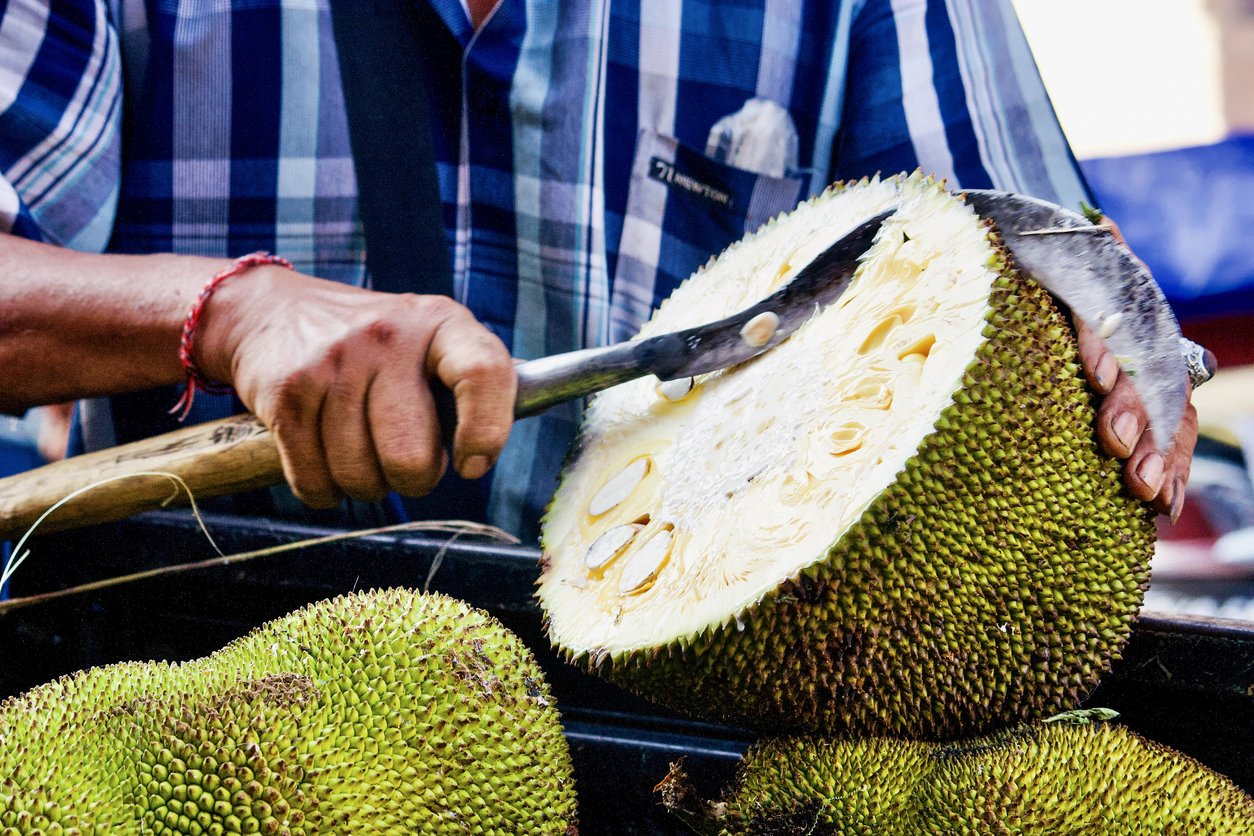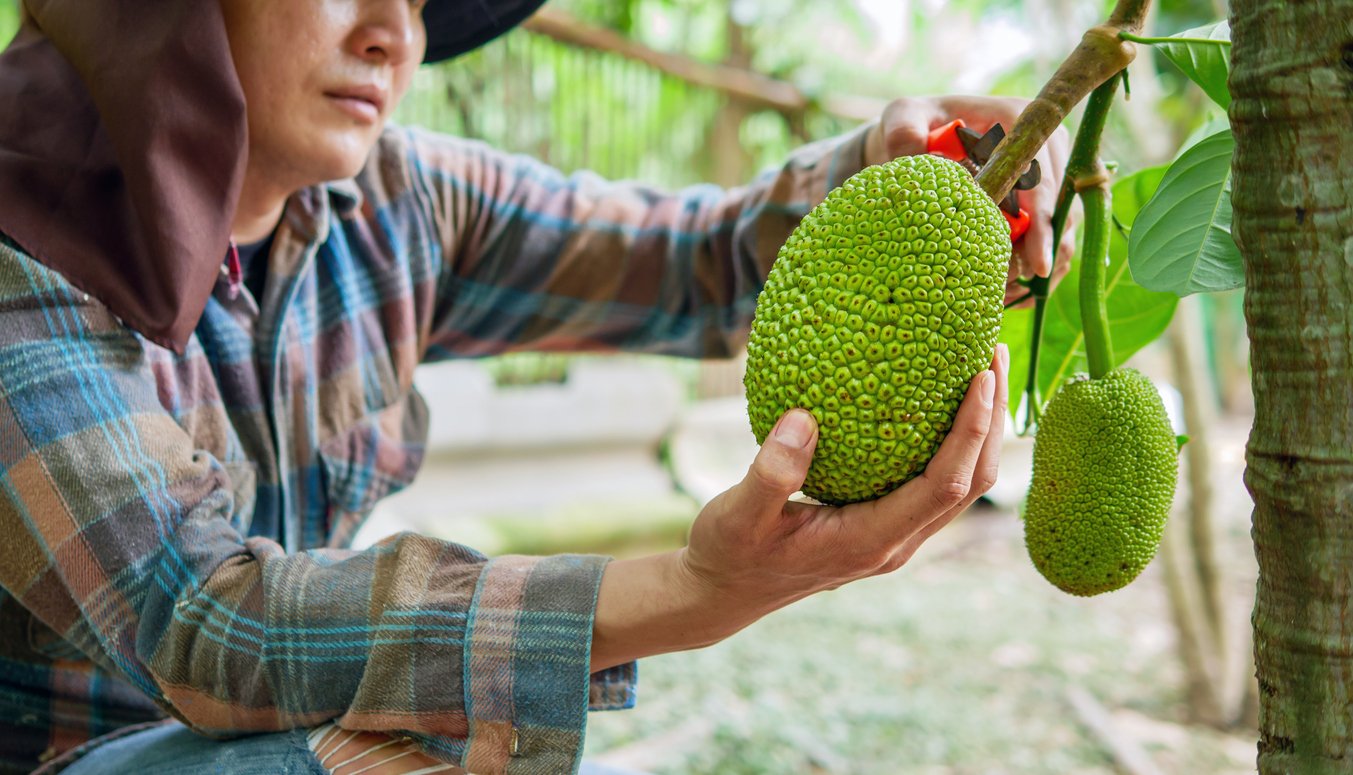Have you heard of jackfruit yet? In some parts of the world, the colossal and fascinating tropical fruit is taking the culinary world by storm. It’s emerged as a promising plant-based meat substitute due to its meaty texture and versatility in both sweet and savory dishes, whether raw or cooked.
But jackfruit is already a staple food in many traditional dishes across South and Southeast Asia. One jackfruit tree can produce up to three tons of food from this huge and utterly unique fruit per year, providing an almost miraculous source of nourishment and income for people in India, Thailand, and Malaysia, among others.
So, if you’re curious about jackfruit — or have seen jackfruit tacos and pulled jackfruit BBQ popping up in stores and on menus — read on to find out what’s so great about jackfruit. And why you might want to consider giving it a try.
What Is Jackfruit? Where Does It Grow?

Jackfruit (scientific name Artocarpus heterophyllus) is a species of tree in the fig, mulberry, and breadfruit family. Although they are close relatives, jackfruit is not the same as breadfruit — another spiky tropical fruit beloved in the Pacific and Caribbean islands with some similar characteristics. Jackfruit is much larger than breadfruit and is higher in natural sugars and fat.
Other names for jackfruit include kathal (in Hindi), Phanasa (in Marathi), kanun (in Thai), nangka (in Indonesian and Malaysian), jaca (in Portuguese), or “tree mutton” in the Caribbean.
The jackfruit tree originated in southwest India, where it grows abundantly. Throughout history, jackfruit spread to other tropical and subtropical areas, including additional regions of India, Southeast Asia, the East Indies, the Philippines, Thailand, Malaysia, and Indonesia.
It also grows in Africa and is relatively popular in Brazil, Australia, and Suriname. In the US, jackfruit is primarily grown in Florida and Hawaii and can sometimes be found in grocery stores (especially Asian markets) and natural food stores, either fresh, frozen, dried, or canned.
The largest tree-borne fruit in the world, jackfruit can weigh up to 100 pounds and grow up to three feet long. (The average size of the fruit is 10–25 pounds.)
The huge trees produce massive, green, oblong fruits with a bumpy, fleshy exterior. On the inside, jackfruit is filled with many pale yellow plump bulbs, which are edible and joined at the core. The seeds can also be cooked, eaten on their own, or ground into flour.
A ripe, unopened jackfruit has a strong, smelly odor — like a combination of fruit and onions. But the pulp of the opened fruit smells sweet.
What Does Jackfruit Taste Like?
When eaten ripe, the taste of jackfruit is similar to pineapple, mango, and banana. When it’s unripe and green, the jackfruit has more of a neutral vegetable-like flavor, similar to a potato, and works well in savory dishes.
One great thing about green jackfruits is that they don’t have a strong flavor on their own, so they’re able to soak up herbs, spices, and other flavorings. This allows the fruit to be made into plant-based versions of shredded chicken, pulled pork, or other meat-like meals.
Jackfruit can be made into a wide variety of dishes, both sweet and savory. And the seeds are often boiled or roasted and eaten as snacks, with a taste that’s similar to chestnuts.
For more on what to do with jackfruit, including how to cook it, check out our companion article, How to Eat Jackfruit: 7 Delicious Plant-Based Recipes to Try.
Jackfruit Nutrition

Jackfruit isn’t only a fun and meatless way to add something new to your usual meals. It’s also rich in nutrients, including fiber and antioxidants.
Jackfruit’s nutrition is impressive. One researcher even called it a “miracle” food because it provides so many nutrients.
A one-cup serving of jackfruit contains 143 calories and boasts the following lineup of vitamins and minerals:
- Fiber: 2.3 grams
- Protein: 2.6 grams
- Carbohydrates: 35.1 grams
- Thiamin (B1) 13% of Recommended Daily Intake (RDI)
- Vitamin B6: 29% of RDI
- Folate (B9): 9% of RDI
- Vitamin C: 23% of RDI
- Magnesium: 10% of RDI
- Potassium: 14% of RDI
- Copper: 13% of RDI
Jackfruit seeds are especially nutritious as they’re high in protein, potassium, calcium, and iron. They’re also a source of resistant starch that has prebiotic activity in the gut.
Jackfruit Benefits for Your Body
There aren’t a lot of studies on jackfruit, especially in its whole-food form. But these are just a few ways it may benefit your health:
Diabetes and Jackfruit
Recent studies reveal jackfruit’s promising role in managing type 2 diabetes. One study demonstrated that incorporating jackfruit flour into the diets of individuals with type 2 diabetes significantly improved markers of blood sugar control, including reductions in HbA1c as well as both fasting and postprandial glucose. This result indicates that jackfruit flour could serve as an effective component of medical nutrition therapy for diabetes.
Another investigation focused on the blood sugar-lowering properties of jackfruit seeds. This study used animal models to show that jackfruit seed extract could significantly reduce blood glucose levels and possibly enhance the effects of diabetes medications. (Our view on the use of animals in medical research is here.)
Even jackfruit leaves may have medicinal qualities. In Indian Ayurveda tradition, consuming hot water extracts of (jackfruit) kathal leaves is said to help treat type 2 diabetes.
Collectively, these studies and traditional uses suggest that different parts of the jackfruit — be it the flour, seeds, or leaves — could be beneficial in the dietary management of diabetes.
Jackfruit and Eye Health

Jackfruit is a rich source of phytochemicals, especially carotenoids. Both provitamin A carotenoids like beta-carotene and non-provitamin A carotenoids like lutein and zeaxanthin are found in jackfruit. These plant compounds are known for their eye health benefits, with the latter two accumulating in the macula of the eye, which protects against age-related macular degeneration.
Jackfruit’s Heart Benefits
Jackfruit’s antioxidant content may have beneficial properties for your heart. Oxidation in the body can contribute to inflammation and even elevate blood cholesterol and blood pressure. The antioxidants in jackfruit work to combat oxidation and free radicals, preventing their accumulation in cells and organs like the heart.
The soluble fiber content of jackfruit may also have a cholesterol-lowering effect. Higher amounts of fiber intake are associated with lower overall cholesterol levels as well as lower LDL cholesterol.
Anticancer Benefits of Jackfruit

There’s a lot of controversy over so-called “antinutrients” and whether or not they’re good for you. But researchers have found they serve a protective purpose for plants — and people.
Jacalin, a lectin found in jackfruit flesh and seeds, may be particularly beneficial for the immune system and staving off cancer. One study tested jackfruit’s phytochemical activity against human colon cancer cells. The study’s findings showed that jackfruit had an impact on both normal and cancerous cells, mainly through its impact on the immune system and its antioxidant activity.
Another study took this evidence further by demonstrating jacalin’s ability to modulate macrophages (an important type of white blood cell), effectively initiating the elimination of tumors in the body.
Saponins can also stop cancer cells from replicating. In one study, 35 mg/mL of jackfruit seed extract showed evidence of angiogenesis prevention, stopping the creation of new blood cells in tumors.
A Sustainable Choice for a Growing World
With its huge size, impressive nutrient density, and crowd-pleasing taste, jackfruit could be one of the most promising solutions for sustainably feeding the world.
Amazingly, one jackfruit tree can grow about 100–200 fruits in a year. That’s up to a ton of fruit per year, from one tree!
Compared to the intensive land and water resources necessary to produce meat, jackfruit is far more efficient as a global food source.
Danielle Nierenberg, president of Food Tank (which promotes healthy and sustainable agriculture) told The Guardian this about jackfruit:
“It is easy to grow. It survives pests and diseases and high temperatures. It is drought-resistant. […] It achieves what farmers need in food production when facing a lot of challenges under climate change.”
Some jackfruit producers, such as The Jackfruit Company, are also working to produce the fruits with regenerative agriculture and help secure organic certifications for farmers.
Crudely nicknamed the “poor man’s fruit,” researchers are aiming to increase jackfruit consumption in India, where the food has mostly fallen out of favor and often goes to waste. Making jackfruit a favorite staple food again could help feed millions of people who are facing food insecurity. It could also help boost the income of farmers, due to the many marketable products derived from jackfruit trees and fruit.
Jackfruit in the US

While jackfruit is a sustainable food choice in Southeast Asian countries, the sustainability of jackfruit is more complex in the US, Canada, and Europe because of transportation. While some jackfruit is grown in Hawaii, Florida, and Mexico, the majority of jackfruit in North America and Europe is imported from India, Vietnam, and Thailand.
Shipping jackfruit long distances involves significant food miles, contributing to carbon emissions and energy consumption. This diminishes some of the environmental benefits.
However, researchers also tell us that when foods are shipped, the carbon footprint of the shipping, while real, is less significant than the carbon footprint of packaging or of the food itself. In other words, from a climate change perspective, it’s probably much better to eat jackfruit from the other side of the world than beef from next door.
Disadvantages of Jackfruit
While jackfruit has many potential benefits and applications, there are also a few downsides to consider.
Latex Allergies
Jackfruit contains a sticky, white sap in its skin and core that has proteins similar to latex. As such, it can cause reactions in those sensitive or allergic to latex. Contact with its sap during the handling and preparation of fresh jackfruit can lead to skin irritation or, in rare cases, more severe allergic reactions like anaphylaxis.
If you have a latex allergy, it’s crucial to take precautions such as wearing gloves while cutting the fruit or, in some cases, avoiding the fruit altogether to prevent any adverse reactions.
Medication Interactions

As we saw when examining its health benefits, jackfruit can lower blood glucose levels, especially when it’s consumed in large quantities. However, this effect might complicate blood sugar management for individuals with diabetes. For those taking diabetes medications, such as insulin or sulfonylurea drugs, hypoglycemia could occur with excessive jackfruit consumption.
Additionally, because jackfruit is high in potassium, it can have an effect on certain medications, such as beta-blockers. These drugs are used to treat heart conditions by blocking beta-receptors that control signals in the sympathetic nervous system, regulating essential systems like your heartbeat. But beta-blockers also block potassium channels, causing an increase in serum potassium levels. Excess dietary potassium intake can increase the risk of hyperkalemia, causing an imbalance in electrolytes. Moderation may be key here, especially if you have a preexisting health condition.
Anyone taking medications for either of these conditions should consult with a health care provider before incorporating significant amounts of jackfruit into their diet to ensure there are no adverse interactions.
The Final Word on Jackfruit
Jackfruit is a remarkable fruit that offers a multitude of benefits for health, sustainability, and culinary versatility. Depending on whether you eat it unripe and green or ripe and yellow, it can be savory and “meaty” or a sweet and delicious fruit. As a sustainable crop that grows in huge quantities, it holds promise as a food security solution in tropical regions. Its nutritional profile and potential health benefits make it a worthy addition to most dietary patterns.
It also offers an interesting way to expand culinary horizons around the world — especially as a plant-based meat substitute.
You can eat the whole fruit as is or choose frozen, canned, or dried jackfruit pieces. Many processed jackfruit products also exist that do most of the preparation for you, but may also include excessive sodium and undesirable food additives and other ingredients. Like most foods, eating jackfruit closest to its whole form will give you the most health benefits.
Tell us in the comments:
- Have you eaten jackfruit? Why or why not? What did you think?
Featured Image: iStock.com/bhofack2

